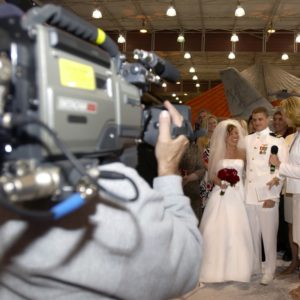 Previously, I noted that wedding videos are more memorable than videos (click here). Now let me flip to the other side (I’m fickle).
Previously, I noted that wedding videos are more memorable than videos (click here). Now let me flip to the other side (I’m fickle).
Let me explain what your brain likes about videos. There four reasons your brain likes videos.
First, perceptually, we are very oriented to action. Before the age of 3, or if you have ADHD or brain damage, it is impossible to not turn and look at something new. It’s built in.
Remember the Pixar movie Up and “squirrel!”? We start out the same way. We love motion. As we get older, our prefrontal cortex grows and we develop the ability to override our natural orientation tendency. We can more or less control ourselves.
 There are some motions, though, which are still irresistible to us. We love watching a curving motion. Magicians take advantage of this by distracting us from one hand by moving the other hand in an up and curved motion. It is hard for us to not follow the path.
There are some motions, though, which are still irresistible to us. We love watching a curving motion. Magicians take advantage of this by distracting us from one hand by moving the other hand in an up and curved motion. It is hard for us to not follow the path.
The brain does some amazing processing with objects in motion. It highlights the moving object. That is, it emphasizes the foreground. This would be enough to make objects clear but the brain has another trick too. It defocuses the background.
Film editors were among the first to notice this phenomenon. They worried about cutting from scene to scene when the background didn’t match. They thought it would ruin the experience. Turns out our brains come to the rescue.
In general, we don’t notice backgrounds. Even large changes are ignored. In psychology, the phenomenon is called change blindness. Unless by chance we are looking at the background, we don’t notice the shift.
We often don’t notice things in the foreground either. We don’t notice the actor is wearing a hat and then not wearing a hat, in the same sequence. We miss most of the continuity errors made in movies. Our perceptual system is very forgiving.
Second, videos come with sound. You get to hear the voices of everyone there. You get to hear the excitement, the nonsense conversations, and the echoes of the building.
You get to hear the intimate moments you couldn’t hear from the back of the room. You hear the vows, the toasts, the jokes and the asides. It feels like you are there.
Third, videos highlight interactions. Photos show where the roads meet but videos show the traffic patterns of conversation. You get to watch and eavesdrop others. You can see the actions, reactions and counter-actions of people being people.
Fourth, photos provide continuous flow. A photo freezes the moment. A video reveals people’s mannerisms, their pacing and their conversational style. You get to both see and hear it.
However…
When it comes to memory, photos are still best. Partly, this is because people look at photos more. For memory the more times you see something the more you remember it. If you want to improve your memory of your videos, watch them more often.
When you watch a video, your brain will summarize it for you. It will extract the meaning, tap it with emotional and locational cues and store it away. But the extracted summary is much more like a photo than a video.
Both photos and videos fade into mental impressions. Our memories of realities become more abstract. It takes a lot less room to remember concepts so we extract the meaning for experiences and just store that.
Our mental abstractions become less and less based on reality. We are experiencers of the world, not archivists. We don’t put things in permanent storage. We adjust our memories to fit our current needs.